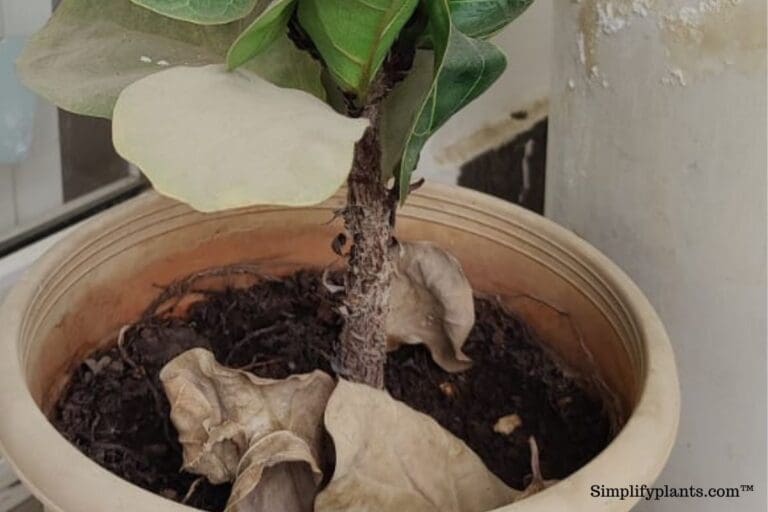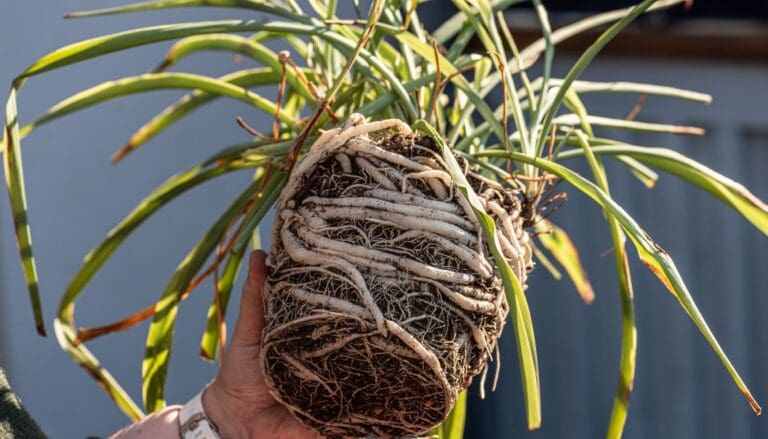Do Calathes Attract Bugs? (Common Pest+Solution)
Calathea is a beautiful tropical plant with exotic leaves. Although it can be tricky to take care of Calatheas, people can’t resist growing them due to their beauty. If you notice holes in your calathea plant’s leaves or stunted growth, your plant might have a bug infestation.
But Are Calathea prone to pests? Let’s find out.
In general, Calathes don’t attract many pests towards themselves unless the plant is exposed to unfavorable conditions. The most common pest that infests a calathea plant is spider mites. Apart from that, pests like mealybugs, aphids, and scales can also infest a calathea plant.
Bugs can be extremely harmful to your Calathea as they can take over the whole plant and make the plant weak and unhealthy, leading to death if you fail to identify the infestation on time.
I will discuss all the bugs that attack your Calathea and how you can get rid of them so keep reading.

Please note: Simplify Plants is reader-supported. Some links in the post are affiliate links and I get a commission from purchases made through links in the post.
Are Calathea prone to pests?
Calathea will not attract pests if it is getting all its requirements and is absolutely healthy. But it might be prone to pests if you don’t provide the right living or growing conditions.
Your Calathea will be prone to pests if:
- It is living in unfavorable conditions such as overwatering.
- It has plants around it that are already infested with bugs.
- You have bought an unhealthy plant and brought it home.
If you don’t want bugs on your Calathea, you need to check the plant thoroughly before bringing it home. You should isolate it for a few days before placing it with other houseplants.
You also need to research and provide the right growing conditions to the plant and keep checking all the plants around it so that the bugs can’t travel from them to these plants.
Now, let’s talk discuss the bugs that attack your Calathea.
Why are Calatheas prone to spider mites?
Unlike most bugs, spider mites prefer dry conditions. Your Calathea might not be receiving enough hydration, making it an easy target of the spider mites.
Here are all the reasons that might be making your Calathea prone to spider mites.
All these conditions make the Calathea dry. Therefore, ideal for spider mites.
What are the signs of spider mite infestation on Calathea?

Spider mites can populate very fast, and then it will get challenging to get rid of them, so you should try to identify the signs early on.
Here are the signs of spider mite infestation on Calathea:
- Brown spots
- Drooping leaves
- Curling leaves
- Leaves not closing at night
- Web-like structures
If you notice these, you should inspect your Calathea and take steps to eliminate the spider mites as soon as possible.
What are the other bugs that infest your Calathea?
Here are the other bugs that might also attack your Calathea plant.
Mealybugs

Mealybugs are not uncommon, and they have soft bodies with cotton-like coating. They feed on the sap and make your Calathea weak.
Mealybugs prefer moist conditions, so these will attack your Calathea if you overwater it. They also secrete honeydew and hide under the leaves.
Aphids

Aphids are not as tiny as spider mites, and you might notice them on the leaves and stems of your Calathea.
Aphids also feed on the sap of Calathea and excrete honeydew. These are usually found in groups.
Scales

Scales have hard bodies, and they stick to the plant body, so it is not easy to get rid of them. These look like small bumps on the stem of your Calathea.
How to get rid of bugs on Calathea?
You can get rid of spider mites and other bugs with the help of the following steps.
1. Inspect the plant
If you suspect that your Calathea has bug infestation, you must isolate the plant and scrutinize it. You must isolate your Calathea so that other plants in your house don’t get infested with bugs.
After isolating the plant, check it thoroughly. Don’t check the visible parts only but the undersides of leaves, as most bugs hide.
If you can’t spot any bugs, hold a paper under the leaves and shake them. If bugs are present, they will fall on the paper.
If the bugs are not very tiny, you’ll be able to spot them without doing this.
2. Prune the affected parts
You might find leaves that have holes or have a lot of bug infestation on them. The best thing is to prune these leaves to prevent the infestation from spreading to the healthy parts.
Always use sterilized pruners to clip off these parts. Also, get rid of the dead and damaged leaves.
You can use alcohol to disinfect the pruners before and after using them. Make clean cuts at 45-degree angles to promote growth in your Calathea.
3. Eliminate the bugs

Now, you need to get rid of the bugs on your Calathea. There are many ways to do so. You can either opt for an organic solution or a chemical one.
I recommend going for the organic solution first. If that doesn’t solve the problem, you must get a chemical pesticide available in the market.
Wash the plant: You should wash your Calathea with a strong force of water to get rid of as many bugs as possible.
Use neem oil: This is an effective solution against all bugs. It is natural and harmless for the plant. This kills not only the bugs but also the eggs and larvae.
You can add 1 tsp of neem oil to 1-liter water and spray this on your Calathea till you get rid of the bugs. Do this for at least two weeks.
Don’t expose your Calathea to bright or direct sunlight after applying neem oil on it.
Rubbing alcohol: Take a cotton ball, dip it in alcohol and wipe the bug-infested parts with it. The bugs will get killed due to the alcohol.
Peppermint oil: You can use this as it will eliminate the bugs effectively. Mix 1 tsp of peppermint oil with 1-liter warm water and spray it on your Calathea.
Pyrethrum spray: Pyrethrum affects the nervous system of bugs and kills them. You can buy one online and use it on your Calathea. However, be careful as it might be harmful to pets and children.
Garlic spray: You can make this yourself with garlic and water. You can blend the garlic and mix it with 2 cups of water. Mix them well and leave them aside for a day.
Pour this mix into a spray bottle. Spray the Calathea with it every week.
Wear a mask and use gloves while using this spray.
Nematodes: Find natural predators that feed on the bugs that are infesting your Calathea. For example, ladybugs feed on spider mites.
If these don’t work, you can use chemical pesticides to get rid of the bugs.
4. Take care of the plant the right way
After getting rid of the bugs, you need to take care of your Calathea well correctly. You can do some research and find out what your Calathea prefers.
To give you a brief idea:
- Calathea prefers slightly moist soil.
- Bright indirect light is ideal for Calathea.
- You must not keep your Calathea in soggy soil.
- Try to provide warm conditions and high humidity.
- Fertilize with a diluted dose of fertilizer during the growing season.
- Keep your Calathea clean by wiping the leaves and the stems.
How can we prevent pests in calathea?

Now you know how you can get rid of bugs on Calathea so let’s understand how you can prevent them.
- Spray a neem oil solution once a month on your Calathea.
- Inspect your plant at regular intervals so that you don’t miss the signs.
- Isolate your Calathea after bringing it home. Ensure that the plant is healthy and doesn’t have any bug infestation so that your other houseplants don’t get affected.
- Don’t overwater the Calathea as pests like mealybugs and aphids prefer moist conditions.
- Don’t underwater your Calathea as dry conditions will attract spider mites.
- Mist your Calathea and wipe the leaves to keep them clean. This will also provide some humidity to your Calathea.
- Keep your Calathea away from other houseplants. Bugs tend to travel from one plant to the other, so keeping them together might not be a good idea.
Final words
A healthy Calathea will never be prone to bugs since bugs infest plants living in unfavorable conditions, making them weaker. Bugs feed on the sap and take all the nutrients out of the plant.
Bugs can be deadly as they reproduce and grow a colony very fast. If you don’t act fast, they will take over your Calathea and make it so weak that it will be challenging to recover it.
If you have a bug-infested Calathea, use the above methods to get rid of them and start taking good care of the plant. Provide it with sufficient light, water, and fertilizer, and keep a constant check on it.
Keep your Calathea healthy to keep the bugs away from it.
Source: NCBI, University of Florida, Wikipedia, Growing Indoor Plants with Success, Agriculture, and Natural Resources, University of California, Missouri Botanical Garden.
Recommended Garden Supplies
| Product Image | Our Recommended Gardening Supplies | Check Offers! |
|---|---|---|
Top Top
Top
Top
Top
Top
Top
Top
Top | rePotme Houseplant and Tropical Classic Potting Soil Mix | Check Offer On Amazon |
 Top
Top
Top
Top
Top
Top
Top
Top | Espoma Organic Indoor Plant Food | Check Offer On Amazon |
 Top
Top
Top
Top
Top
Top
Top
Top | GooingTop LED Grow Light 6000K Full Spectrum Clip Plant Growing Lamp | Check Offer On Amazon |
 Top
Top
Top
Top
Top
Top
Top
Top | Soil Moisture Meter | Check Offer On Amazon |
 Top
Top
Top
Top
Top
Top
Top
Top | Govee Hygrometer Thermometer, Bluetooth Enabled! | Check Offer On Amazon |
 Top
Top | LEVOIT Humidifiers for Large Room(Best For Plants) | Check Offer On Amazon |
 Top
Top
Top
Top
Top
Top
Top
Top | Upgraded DIY Automatic Drip Irrigation Kit, 15 Potted Houseplants Support | Check Offer On Amazon |
 Top
Top
Top
Top
Top
Top
Top
Top | Stainless Steel Heavy Duty Gardening Tool Set | Check Offer On Amazon |
 Top
Top
Top
Top
Top
Top
Top
Top | Bonide Insecticidal Soap | Check Offer On Amazon |
 Top
Top
Top
Top
Top
Top
Top
Top | Bonide 32 oz Spray Neem Oil for Organic Gardening | Check Offer On Amazon |
 Top
Top
Top
Top
Top
Top
Top
Top | Garden Safe Fungicide | Check Offer On Amazon |






